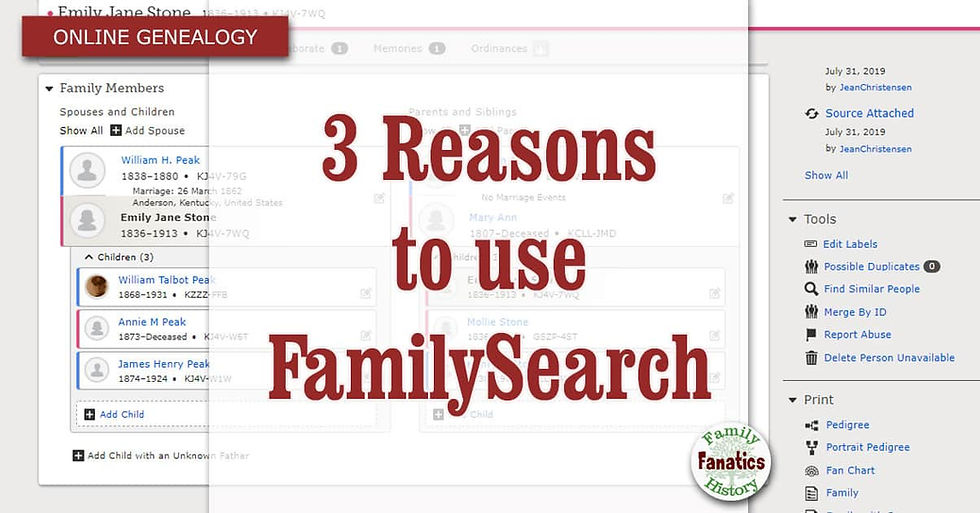3 Reasons to Use FamilySearch
- Devon Noel Lee

- Aug 28, 2019
- 4 min read
Updated: Nov 7, 2024

As budding genealogists attempt to use FamilySearch Family Tree, they quickly face a learning curve that's not as easy as other online offerings. Learning to add reason statements when making a change, attaching a source, merging people, or deleting a relationship can be overwhelming. But anything worth doing is worth doing well.
With FamilySearch Family Tree, three reasons to use the program outweigh the learning curve associated with mastering its mechanics.
1. Public Trees and Public Sources
With FamilySearch, there are no private trees. Okay, the private trees are the living individuals you add to the tree. But when we're talking about the history of deceased persons, no one is private. So, although you might want to believe this is blasphemy, look through the eyes of a friend's story.
My friend wanted to work on her family tree using an online service that allowed private trees. She found a match to a public tree that indicated that it had sources. This friend was super excited!
She hadn't discovered any sources for this ancestor before, so she excitedly contacted the private tree owner. However, when she reached out to the owner of the private tree, her excitement deflated.
This person had worked on the ‘common’ ancestor but gave up the chase. Why?
The common ancestor was actually on her ex-husband's line. As such, the tree builder should have separated off the ex-husband's line, made that tree public for other researchers, and forgotten about it. But instead, she kept it as part of her primary, private tree.
Sadness occurs when the ex-wife doesn't share the sources she accumulated for the tree branches she no longer cares about. Her research would have helped my friend, but the private tree owner doesn't want to be bothered. Perhaps the tree owner had painful memories open up when the ex-husband's family contacted her, and we all wanted to hug her.
However, her research would have been public on FamilySearch. That way, my friend could climb the ex-husband's family tree and see the accumulated sources.
In FamilySearch Family Tree, I have contributed numerous sources to branches I may never visit again. Part of my efforts is purely service-oriented. Part of my research involves hunting down potential friends, associates, and neighbors to my direct ancestor.
Whatever the reason, these people are on FamilySearch Family Tree with all the documentation I used to make the associations. No one has to request what sources I used because they are ready.
↪️ Are you looking for more genealogy resources?
Grab your copy of these FREE Genealogy Research Guides.
2. Longevity of Research
Another benefit of FamilySearch Family Tree is that my research will likely live on after I have passed away.
Time and time again, I run into individuals who want to know, “What will happen to my stuff when I die?”
Your research in your file cabinets and binders will likely go in the trash heap.
You may have a descendant who sees the importance of saving your original records. But far too many people I encounter feel that is a huge maybe.
Use FamilySearch Family Tree as the repository for your research and stories. The organization backing the service has accumulated and shared family history since at least the 1850s.
They’ll do everything they can to preserve your stuff. In addition, FamilySearch will make it available for your descendants and distant relatives who want to know your story and the stories of your loved ones
3. Reduce Duplication Errors
Recently, someone thanked me for posting a naturalization record for her direct ancestor. This ancestor is the stepfather of my second great-grandfather, Henry Joseph Geiszler.
I had searched for naturalization records, hoping to locate the one belonging to Joseph Geissler. However, I stumbled upon Michael Billman's documentation instead.
I copied the image when I was in the repository and then added the naturalization record to FamilySearch. So when Michael's direct descendant came across the picture, she connected with him more deeply, and she didn't need to look for the record I had already discovered.
I enjoy uploading documents or attaching sources using FamilySearch to my relatives and those who aren’t part of my family. I don’t do this process randomly. Instead, I’m methodical about why I’m making discoveries.
But there's no sense in making others search for information I have already processed and uncovered. I can add a record to my ancestor and tag others in a few moments. These efforts are my contribution to the power of the crowd.
FamilySearch, as a collaborative network, seeks to reduce duplicated research efforts. Eventually, we can spend less time searching for identical records for the same ancestors repeatedly. Instead, we can spend our research effort exploring little-known record sets like the Post Office, Justice of the Peace, and Circuit Court collections.
Overcome the FamilySearch Learning Curve
If you're a beginner with a learning curve in genealogy, build your skillset using FamilySearch. Find an ancestor on their open-edit tree. When you do, you'll have access to the stories and sources already discovered and connected to your relative.
What you contribute to the tree will live on long into the future. Plus, you won't look for identical records that others have already found.

.png)




Comments